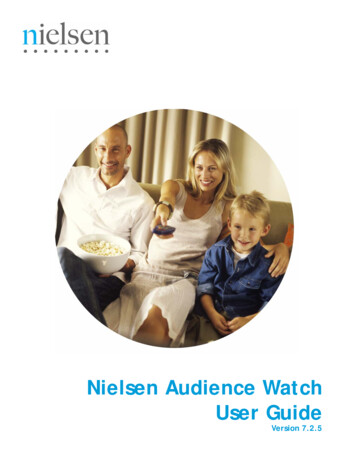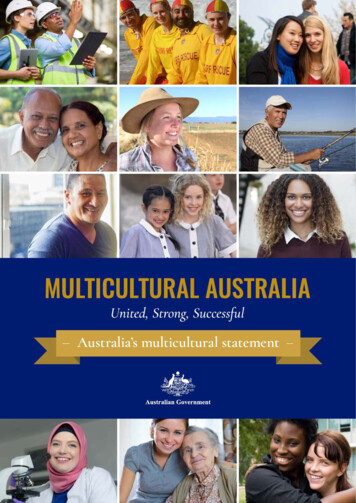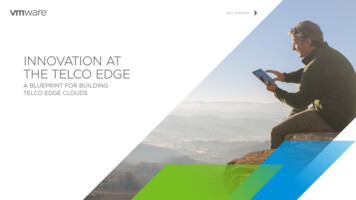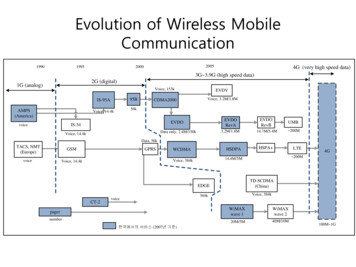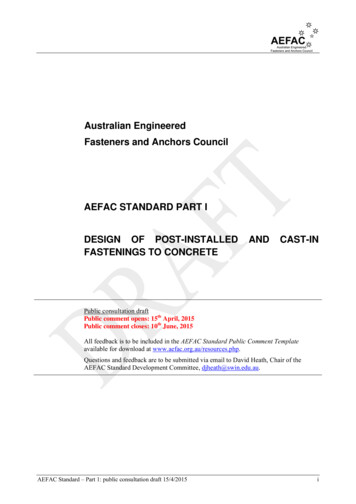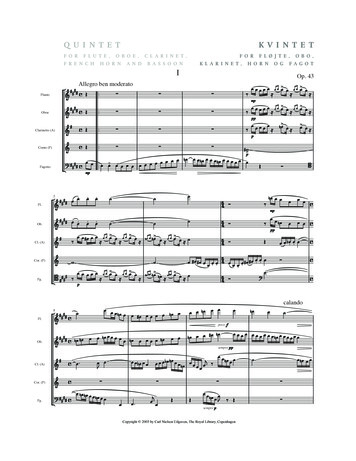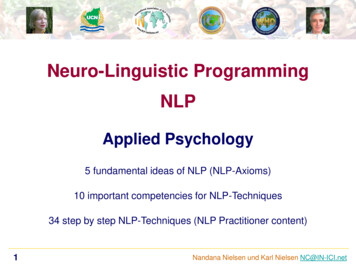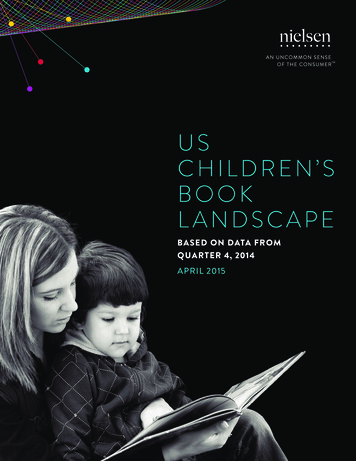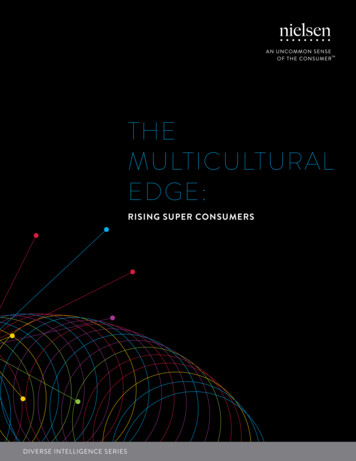
Transcription
THEMULTICULTURALEDGE:RISING SUPER CONSUMERSDIVERSE INTELLIGENCE SERIES
FOREWORDThe Multicultural Edge: Rising Super Consumers is a fresh perspectiveon multicultural consumers as the emerging consumer force in Americatoday. It builds on the previous series of groundbreaking analytic reportson the attitudes and behaviors of African-American, Asian-American andHispanic consumers and illustrates why companies should considermulticultural consumers as the cornerstone of today’s successfulmarketing strategies.As the nation’s three largest multicultural groups continue their upwardtrajectory in both numbers and buying power, the need for a nuanced,culturally acute roadmap to the youngest and fastest-growing segmentof the U.S. population has never been greater. This report shows thatmulticultural consumers, both individually and collectively, alreadyrepresent more than their numerical share across a wide swathe ofproduct categories. They are leading the way in digital devices and socialmedia, which they use to celebrate and maintain their evolving culturalidentities, as well as to connect with each other and the world aroundthem. In many product categories, they are “super consumers,” as thiscomprehensive report will illustrate.Multicultural shoppers may be the key to the future, not just becauseof their numbers, youth and economic clout, but because theirunprecedented influence on the attitudes and consumption habits ofnon-multicultural consumers is upending outdated assumptions andenlarging and expanding the multicultural market opportunity. What’smore, the way culturally diverse shoppers cluster in certain regions andmetro areas is amplifying their impact within and across all consumergroups, and extending their buying patterns. Most important, marketersand advertisers who grasp and activate the multicultural edge willbe poised to connect with rising super consumers and thrive in anincreasingly multicultural mainstream.Yours truly,Mónica GilSVP and General ManagerMulticultural Growth and Strategy2Saul RosenbergChief Content OfficerTHE MULTICULTURAL EDGE: RISING SUPER CONSUMERS
EXECUTIVESUMMARYMulticultural consumers are transforming the U.S. mainstream.Propelled by the twin engines of population growth and expandingbuying power, they are at the leading edge of converging demographicand social trends that are reshaping how marketers and advertisers useculture to connect with increasingly diverse customers. By understandingthe cultural essence that drives multicultural consumer behavior today,marketers and advertisers are getting a glimpse of future market trendsand forging a long-term relationship with the most dynamic and fastestgrowing segment of the U.S. consumer economy.Media-savvy and socially empowered, multicultural consumers are: Empowered and culture-driven shoppers, who over-index on a widerange of products and services. In an increasing number of consumerproduct categories, multicultural consumers comprise a highpercentage of the “Super Consumers,” the top 10% of householdswho drive at least 30% of sales, 40% of growth and 50% of profits.Multicultural consumers, who are seeking brands that speak to theirculture, self-image and aspirations, often geographically cluster withnon-multiculturals who share their brand and product preferences in“Super Geos.” Younger than the rest of the population, they are trendsettersand tastemakers across a broad range of categories, from foodand beverage to beauty products. Cultural traditions and socialaspirations that drive multicultural shopping and product behaviorsare also resonating with many mainstream shoppers, which increasesreturn on investment and magnifies the business case for reachingmulticultural consumers. In their prime, multicultural consumers are starting families, makingplans and establishing long-term brand relationships. The compoundeffect of youth and extended life expectancy make multiculturalconsumers a key to long-term growth for products and brands.Copyright 2015 The Nielsen Company3
Expressive and inclusive, an Ambicultural identity1 very often allowsmulticultural consumers to simultaneously maintain their culturalheritage and see themselves as part of the new mainstream, allowingthem to mix and match endless choices and products to suit theireffortless duality in lifestyles and tastes. They are proponents ofexchange who love to share their personal cultures and explore thecultures of others. Connected and mobile savvy, multicultural consumers use theirsmartphones and other devices at much higher rates and moreintensely than their non-multicultural counterparts. Their socialnetwork profiles are inherently cultural, and they are voracioususers of mobile entertainment. Multicultural consumers over-indexon popular apps that help them express their cultural and socialidentities. Interethnic and multigenerational, they are leading the CulturEdge .2As a result, the multicultural selling proposition for marketers andadvertisers extends beyond the size of the multicultural population.Just as soul food, sushi, tacos, pizza and other once-ethnic foodshave become as ubiquitous as apple pie and hot dogs, the traditions,attitudes and shopping behaviors of multiculturals are influencingmainstream consumers, expanding the multicultural marketopportunity.Ambicultural and CulturEdge areregistered service marks of EthniFacts, LLCand are used with their permission.1,24THE MULTICULTURAL EDGE: RISING SUPER CONSUMERS
co n te n tsEXECUTIVE SUMMARY.03GLOSSARY OF ESSENTIAL TERMS.06SECTION I—THE NEW MAINSTREAM.07Growth in Population and Buying Power.07Youth Drives ROI Advantage.10Multicultural Majority in Major Population Centers.12SECTION II—MULTICULTURAL BUYING AND SUPER CONSUMERS.15Significant Buying Categories.15Multicultural Mind-sets.17Multicultural Super Consumers.18Cross Category Super Consumers.21Multicultural Super Geos.22Multicultural and NHWhite Category Comparison.24SECTION III—CULTURALLY DRIVEN BEHAVIORS.26Culture Sustainability and Sharing.26MULTICULTURAL CONSUMERS: Culturally and Digitally Connected.29CONCLUSION.33METHODOLOGIES.34Copyright 2015 The Nielsen Company5
GLOSSARY OFESSENTIAL TERMSSuper Consumers are a key group to unlocking profitable growth in anycategory. They are the subset of consumers who drive the most value and arethe most involved in a given category. Emotionally and economically engaged,they are the top 10% of households who drive at least 30% of sales, 40% ofgrowth and 50% of profits. They are the speediest path to super insights andstrategy in any business landscape and the difference between holding steadyand unlocking significant growth.Super Geos are geographies with a higher concentration of Super Consumers.Very often these areas have a network effect in that even people who don’tqualify as Super Consumers tend to spend more on a given product category,resulting in strategically important local profit pools.Ambicultural refers to the ability and willingness to function competently intwo cultures. For many U.S. multicultural consumers, this is not a transitionbetween two cultures, but rather an aspirational and behavioral destinationthat includes a shift from both the less and more acculturated sides of thetraditional culture model.Multicultural Consumers are defined using the U.S. Census Bureau definition,as being composed of several different race categories—Black, AmericanIndian, Asian, Pacific Islander, Other, and Two or More Races. Hispanics ofany race are also considered multicultural consumers, defined by the U.S.Census Bureau as an ethnicity, not a race.CulturEdge refers to the social spaces where people of any race or ethnicityexchange their distinct cultures with parity and reciprocity. Those socialspaces include physical places or venues with multiethnic proximity, virtualones as in social media, shared lifestyle orientations, popular cultureaffinities, and more. CulturEdge consumers are adopting or have alreadyadopted cultural attitudes and behaviors of one or more distinct culturesbeyond their own.Non-Hispanic Whites are defined using the U.S. Census Bureau definition, asthose who identified White as their race and an ethnicity other than Hispanic/Latino. We will refer to these as NHWhite in this report.New Mainstream* is used to describe the emerging multicultural U.S.marketplace. As the population shifts, and the old mainstream becomes morediverse, it is no longer a valid business strategy to assume that ethnicityand race will eventually become irrelevant and dissolve into a homogenous“general market.” Instead, marketers should adjust and update their effortsto address a new mainstream marketplace that reflects and acknowledgesconsumers of all races and ethnicities as the source of new social trends andbusiness growth and develop activation strategies based on this reality.*The New Mainstream: How the Multicultural Consumer Is Transforming American Business6THE MULTICULTURAL EDGE: RISING SUPER CONSUMERS
SECTION ITHE NEW MAINSTREAMGrowth inPopulationand BuyingPowerU.S. MULTICULTURAL CONSUMERS ARE 120 MILLION MULTICULTURAL AMERICANS ARE A LARGE,YOUNG, AND GROWING ral growth is a product ofboth immigration and birth rates.Source: 2014–2019 Nielsen Pop-Facts demographicsNote: For our purposes, Multiculturals equal the Total Population minus the Population that is White and not Hispanic/Latino.Multicultural consumers are the fastest growing segment of the U.S.population. Already over 120 million strong and increasing by 2.3 millionper year, multicultural populations are the growth engine of the futurein the United States. Hispanics, African-Americans, Asian-Americansand all other multiculturals already make up 38% of the U.S. population,with Census projections showing that multicultural populations willbecome a numeric majority by 2044. The U.S. Census Bureau is currentlyreviewing the addition of a MENA category for people of Middle Easternor North African descent on the 2020 decennial census. Currently, largelyidentified as NHWhite, this potential change could affect the date of themajority-minority tipping point.Copyright 2015 The Nielsen Company7
Multicultural growth is a product of both immigration and birth rates.In 2012, the Census Bureau announced that NHWhites accounted fora minority of births for the first time in U.S. history. For NHWhites,the number of children the average woman is predicted to have inher lifetime is 1.8, but it is higher for Hispanics (2.2) and AfricanAmericans (1.9).3In sheer numbers, Hispanics will experience the most growth amongmulticultural consumers, growing from 17% of the total populationin 2013 to 29% by 2060. According to Census projections, by 2020,Hispanics will account for over half of all U.S. population growth andnearly 85% by 2050. African-American growth will accelerate to 18% oftotal population growth by 2020 and increase to 21% by 2060, whileAsian-Americans will be responsible for 15% of total growth by 2020and increase to 19%. As the NHWhite population ages, their shareof growth will begin to decline. This dramatic shift will occur as a 7%growth share in 2020 for NHWhites will become a decline of 6% by2030. In 2012, for the first time, the U.S. Census reported that due totheir more advanced age profile, NHWhite mortality exceeded births,and net gains for NHWhites were based on immigration.Multicultural and mixed-race Americans are changing the face ofthe future. Prior to the 2000 U.S. Census, respondents only had theopportunity to pick one box for self-ascribed race. Beginning in 2000,more than one box was allowed, and 2010 was the first opportunityto view multiple race growth data. The 2010 Census showed thatwithin one decade, growth of the multiple-race population increased32%, while the single race population increased by only 9%. In thisenvironment of culture sharing and shifting, the emerging culture willbe led by a mixed blend of people from various backgrounds, and nosingle race or ethnicity will comprise a majority. Further data from theU.S. Census American Community Survey shows that between 2006and 2014, multiple race populations grew 77%, while NHWhites inmulticultural households increased by 30%. This indicates a strongeropportunity through proximity for cultural sharing and blending thatincreases the pool of consumers with a multicultural mind set.In 2010, the U.S. Census10-year growth rate was 32%for Multiple Race population vs. 9% for Single Race population.American Diversit yis Destiny92%of the total growth inU.S. POPULATION from2000 to 2014, camefrom multiculturalconsumersPop2014 2060(millions) (%Pen) (%Pen)Hispanic5617.6% 29.3%NON-HISPANIC WHITE19762.1% 42.6%African-American4012.7% 14.7%Asian-American165.0%8.2%Other/2 Races144.3%8.2%Source: Nielsen Pop-Facts, CY2014 with U.S. CensusBureau, 2060 projections (Dec 2012) with reportednumbers to exceed 100% due to allocation/overlap forHispanics of mixed race. Included in “Other/2 ” are3.1 million native American Indian and Native Alaskans(AINA), plus 600,000 Native Hawaiian & PacificIslanders (NHPI), all generally of moderate growth.Even asimmigrationslows, Americawill inexorablybecome morediverse.382013 American Community SurveyTHE MULTICULTURAL EDGE: RISING SUPER CONSUMERS
Majority of future Growth is driven by L atinosGROWTH IN POPULATION BY RACE & ETHNICITY20202030204022.7% 2 19.9%53.5%63.7%NON-HISPANIC WHITEGrowth Volume (net new, 549,869By 2020,Hispanicsaccount forover half ofall growthin populationand 85% by2050.Source: U.S. Census Bureau, Population Projections, December 2012*Includes native American Indian and Native Alaskans (AINA) and Native Hawaiian & Pacific Islanders (NHPI)2012 was the first year that mortality exceeded births for the U.S.NHWhite population. By 2030, the NHWhite population will be decliningannually, and all U.S. growth will be multicultural.Most important for marketers of goods and services, U.S.multicultural buying power is growing at an exponentialrate versus total U.S. consumers, increasing from 661billion in 1990 to 3.4 trillion in 2014. This represents apercentage increase of 415%, which more than doubledthe total U.S. buying power increase of 204%. Themulticultural market’s size, growing clout and buyingpower require thoughtful understanding about what themarket represents to a company’s bottom line.U.S. MULTICULTURAL BUYING POWER 415% 3.4TRILLION 661BILLION19902014Source: Selig Center for Economic Growth,U.S. Census BureauCopyright 2015 The Nielsen Company9
Youth DrivesROI AdvantageMulticultural populations are the fountain of youth for the U.S., and willcontinue to be so for many decades to come. In 2014, multicultural groupscollectively represented greater than 50% of the population under age9 versus 35% of those 45-50, and only 17% of those 80 or older, as eachsuccessive generation is showing a more multicultural skew.Multicultural populations will keep America young and vital even as theworld’s other major industrial nations become older. In a global economy,the youth of America’s population driven by the youth of America’s vibrantmulticultural population will increasingly become an advantage andmake the U.S. the primary long-term growth prospect for many goodsand services for years to come. U.S. Census data shows that in 2013the median age was 37.3 years old4—younger than that of Russia (38.2),the United Kingdom (40.1), France, (40.4), Germany (45.1) and Japan(45.6).5 The substantial age differential between the median age of U.S.multiculturals (30.5) and NHWhites (42) clearly shows multiculturalpopulations are driving this vitality.Life expectancy in the U.S. is at an all-time high according to the U.S.Centers for Disease Control and Prevention. The compound effect of lifeexpectancy and younger median age of multicultural consumers presents apowerful long-term opportunity for businesses if loyalty can be built at anearly stage. Reaching multicultural consumers can be more cost-efficientover time as their effective years of buying power are substantially greaterthan those of NHWhites over their life span. The collective age expectancy,particularly of Hispanics and Asian-Americans, significantly exceeds that ofNHWhites and African-Americans; however, it is the compounding of lifeexpectancy with median age that presents the real opportunity.Each successivegeneration isbecoming moremulticulturalwith THE Gen Nextpopulation, underage 9, alreadyreaching the“tipping point.”American Diversity by GenerationGI GENBOOMERGEN-XMILLENNIALGEN NEXT4510AGE80 �4430–39AGE20–29AGE10–19AGE 92013 ACS Median Age2012 World Health 8%53.8%49.2%Multicultural(all other), %MCNon-HispanicWhite, %NHWSource: Nielsen Pop-Facts, CY 2014 aggregateof single year age by race by ethnicity (ASRE)with collapse Race/Ethnicity into “core” diversitycohorts.THE MULTICULTURAL EDGE: RISING SUPER CONSUMERS
Years of Effective Buying Power StrongestAmong Multicultural ConsumersLIFE EXPECTANCYMEDIAN AGEYEARS OF EFFECTIVEBUYING .774.387.383.54232352736.742.352.356.5Source: CDC NCHS 2010 Life Expectancy/ACS Median AgeFor marketers and advertisers, the greater years of effective buyingpower represented by multicultural consumers translates into abetter long-term return on their marketing and advertising dollars.The effective years of buying power for African-Americans (42.3years), Asian-Americans (52.3 years) and Hispanics (56.5 years) allexceed that of NHWhites (36.7 years). Spending smart marketingdollars on multicultural consumers today will result in many moreyears of consumption and consumer loyalty throughout their lifetimeand increase the return on investment of those dollars spent.When evaluating a multicultural marketing spend, it is essential formarketers to consider not only the short-term ROI of that spend, butmore important the long-term compound effect of a loyal, youngermulticultural population with a much longer life span on the total longterm ROI of that spend.Multicultural households tend to be larger. Higher birth rates andincreasing numbers of intergenerational households are key factorsin the larger size of multicultural consumer households. Thismultigenerational size advantage provides unique opportunities formarketers and advertisers that provide household goods and serviceswith consumption based on household usage.Copyright 2015 The Nielsen CompanyThe multiculturalpopulation leads theway in effective yearsof buying power,exceeding that ofNHWhites. Hispanicsaverage 19.8 more yearsof effective buyingpower, Asian-Americans15.6 more years andAfrican-Americans 5.6more years.11
MulticulturalMa jority inMa jorPopulationCentersTotal U.S. population statistics tend to understate the reality thatthe multicultural future has already arrived in many states and majormetropolitan areas. The multicultural population is currently over 50%in Hawaii, District of Columbia, California, New Mexico and Texas, withNevada, Maryland, Georgia, Arizona, Florida and New York approachingmajority multicultural status. In major metro areas, the reality of amulticultural future is even more apparent, as 21 of the top 25 mostpopulated counties in the United States are already more than 50%multicultural.6In major metroareas, the realityof a multiculturalfuture is even moreapparent, as 21 ofKnowing the cultural appeal of a brand is critical to marketers, asmulticultural populations can vary widely even within metro areas, andefficient marketing today requires knowledge of multicultural densityand growth that calls for not only national, but also regional, local andhyperlocal program reach.the top 25 mostWhile multicultural populations are most heavily concentrated in highpopulation-density metro areas, their growth rates are much higherin many less populated and less urban areas where employmentopportunities can be strong to attract young job seekers. Manynon-border States are showing the fastest growth of multiculturalpopulations as diversity is fueling growth across America.multicultural.populated countiesin the United Statesare already MAJORITYThe combination of majority multiculturalgeographies and high levels of interethnic proximitymagnify the need for ethnic and cross-culturalmarketing and messaging.6122014 Nielsen Pop-Facts DemographicsTHE MULTICULTURAL EDGE: RISING SUPER CONSUMERS
The American Quilt of DiversityNielsen DMAsRanked by % Multicultural (MC)The deeper the shade, thehigher the diversity. Themore dots, greater thenumber of people.Multicultural (37.9%)10,000Hispanic (17.6%)10,000Black (12.7%)Top!10,000Asian (5.0%)59% MC68% MC61% MC48% MCAvg % Pen Index65% 172High48%129Avg.38%101Below26%69Low15%4051% MCSan FranciscoLos AngelesHoustonWashington, DCNew York· Hisp 25%, Black 6%, Asian 24%· 4th ranked· 24% Asian (477 index)· High Chinese, Filipino· Hisp 46%, Black 7%, Asian 13%· #1 largest· Driven by Hispanic, 46%· 79% of Hispanics are Mexican· High Chinese, Filipino, Korean,Vietnamese· Hisp 37%, Black 17%, Asian 6%· 5th ranked· 2nd to LA, broader basis· Vietnamese, Asian Indian,Chinese· 75% of Hispanics are Mexican·········Hisp 14%, Black 24%, Asian 9%8th rankedWide mix, most upscale29% of Hispanics areSalvadoran· 24% of Asians are Asian IndianHisp 23%, Black 17%, Asian 10%2nd rankedPolyglot, driven by all49% of Hispanics are CaribbeanAsian Indian, ChineseTop markets comprise over 31% of all multicultural population in the nation and are 65%multicultural on average, a rate that is 1.7 times greater than the national norm.HOW CAN DEMOGRAPHIC SHIFTS DRIVE MY BUSINESS STRATEGY?1.Integrate multicultural insights into your core business strategy as multicultural consumers account for themajority of U.S. population growth and will soon offset the declining base of non-multiculturals.2.Identify the role of multicultural consumers in your overall business strategy. If they are not the core consumerincluded in your strategy, they are likely to represent a vital growth opportunity.3.Marketing to Millennials and younger generations must be driven by multicultural insights, as younger age cohortsare already over 50% multicultural.4. Average years of effective buying power are greater for multicultural consumers, offering a tangible ROI advantagethrough the effect of dollars spent today.5.Most major U.S. population centers are already majority multicultural, demanding not only specific multiculturalactivation, but also a strategy based on increased cultural influence on the non-multicultural population.Copyright 2015 The Nielsen Company13
Asian-AmericansPOPULATION*: 16 million for single race; 19 million for single race alone or in-combination of mixed raceMEDIAN AGE**: 35LANGUAGE**: 77% of Asian-Americans speak a language other than English at homeEFFECTIVE YEARS OF BUYING POWER: 52Though Asian-Americans represent about 6% of the total U.S. population, their relative affluence allows them todisproportionally outsize their ethnic peers with an estimated 1 trillion buying power by 2018. As a largely immigrantpopulation comprised of key Asian subsegments, they also face the delicate balancing act in propelling themselves to a fastupward mobility in U.S. society and maintaining a strong sense of their Asian identity. As such, Asian-Americans becomediscriminating consumers who are prepared to spend more than their ethnic counterparts on fresh produce, organic foods,eco-friendly products, electronics and buying goods online—categories that are both culturally relevant and central to theirevolving Asian-American identity.African-AmericansPOPULATION*: 41 million for single race; 44 million for single race alone or in-combination of mixed raceMEDIAN AGE**: 31LANGUAGE**: Primarily EnglishEFFECTIVE YEARS OF BUYING POWER: 42Because most African-Americans can trace their status as native-born Americans going back several generations, theirambiculturalism is about balancing their aspirational identities as well as maintaining and bolstering their cultural influence andstatus in an increasingly multicultural society. At 13% to 14% of the population with 1.4 trillion in buying power by 2019, AfricanAmericans have had a profound effect on the overall American population, and as early adopters of technology, this engaged andconnected group has the power to inspire consumer trends. African-Americans gravitate to products that reflect their desire tomaintain ties to cultural traditions and family relations in large cities and culturally to the American South.HispanicsPOPULATION*: 56 million; where 52% are white, 3% are black, 37% are some other race, and 6% are 2 racesMEDIAN AGE**: 27LANGUAGE**: 50.9% speak Spanish more than English, or Spanish only at homeEFFECTIVE YEARS OF BUYING POWER: 56Firmly grounded by their cultural roots even as they strive to take their place in the future, Hispanics view their inherent abilityto straddle multiple nationalities, races and languages as a source of strength and optimism. Buoyed by their growing numbersand buying power projected to be 1.7 trillion by 2019, they are at the crossroads of the CulturEdge, embracing technologyand the cultures of others even as they seek out brands and products that reflect their social expectations and cultural values.Hispanics are looking for brands and products that speak to their present needs around larger, intergenerational families, aswell as grooming products that reflect their rising self-esteem and social aspirations.*Population Estimates: Nielsen Pop-Facts, CY 2014**Age and Language Estimates: 2013 American Community Survey14THE MULTICULTURAL EDGE: RISING SUPER CONSUMERS
SECTION IIMULTICULTURAL BUYING AND SUPER CONSUMERSMulticultural consumers comprise a disproportionate share of manycategories such as dairy, baby food and diapers, laundry supplies anddetergents, school supplies and other family goods. The high percentageof families and youth, and differences in culture, personal needs andlifestyle contribute to many standout categories.SignificantBuyingCategoriesOf 126 grocery store categories reviewed, 45 categories (36%) overindexed in total rate of spending for all multicultural consumerscompared to non-multiculturals. All ethnic segments register highconsumption of dried vegetables and grains. Baby products, diapers,sanitary protection, and cosmetics rank higher among Asian-Americansand Hispanics, possibly related to their relatively young age. Toiletriesand fragrances are prominent for Hispanics and African-Americans.Refrigerated juice drinks are notable across ethnicities and are notonly triggered by the prevalence of families, but also by preferencesfor fruit products and tropical flavors from many countries of ancestry.Sweeteners and molasses make the list for African-Americans, reflectiveof tastes and traditions of the American South.Copyright 2015 The Nielsen Company15
TOP 20 CATEGORIESRANKED BY SHARE OF TOTAL CATEGORY DOLL AR VOLUME SALES (2014)ASIAN-AMERICANRANKAll categories1. Asian noodles2. Vegetables & grains dried3. Photographic supplies4. Disposable diapers5. Skin care preparations6. Meal starters –shelf stable7. Family planning8. Baby needs9. Sanitary protection10. Oral hygiene11. Vitamins12. Fresh produce13. Juice drinks refrigerated14. Personal soap & bath15. Nuts16. Stationery, schoolsupplies17. Cosmetics18. Women’s cosmetics19. Hair care20. Dried %All categories1. Ethnic Hair & Beauty Aids2. Hot sauce3. Feminine hygiene4. Women’s fragrances5. Unprepared Meat, Poultry,Seafood Frozen6. Men’s Toiletries7. Personal Soap & BATH8. Family Planning9. Fresheners & Deodorizers10. Juice drinks refrigerated11. Vegetables & grains dried12. Juice drinks shelf stable13. Coolers14. Spices, seas, extracts15. Shortening, oil16. Greeting cards, partyneeds, novelty17. Bottled water18. Sugar sweeteners19. Table syrups/molasses20. Insecticides, All categories1. Vegetables & grains dried2. Hot sauce3. Women’s fragrances4. Family planning5. Books & magazines6. Hair care7. Men’s toiletries8. Baby needs9. Baby food10. Disposable diapers11. Ice12. Cosmetics13. Sanitary protection14. Children’s cologne15. Meal starters refrigerated16.
8 THE MULTICULTURAL EDGE: RISING SUPER CONSUMERS Multicultural growth is a product of both immigration and birth rates. In 2012, the Census Bureau announced that NHWhites accounted for

